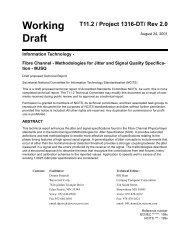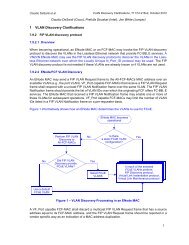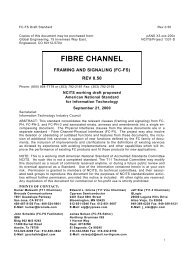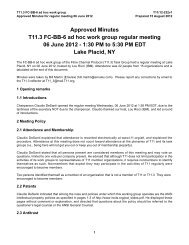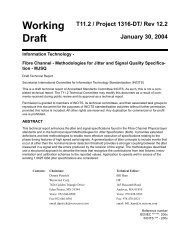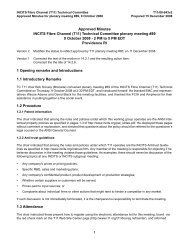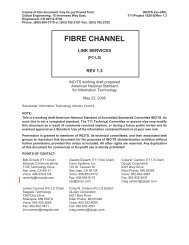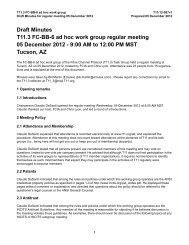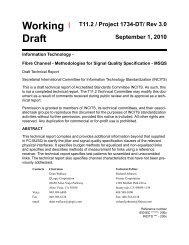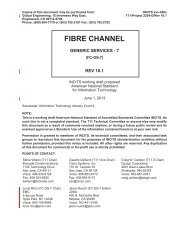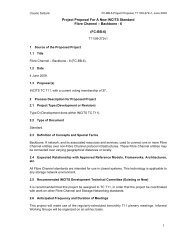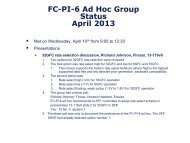FIBRE CHANNEL - T11
FIBRE CHANNEL - T11
FIBRE CHANNEL - T11
Create successful ePaper yourself
Turn your PDF publications into a flip-book with our unique Google optimized e-Paper software.
TR-xx-1998 Fibre Channel Tape Rev 1.07 August 7, 1998<br />
5 FC-2 feature sets<br />
The tables in this clause list features described in FC-PH, FC-PH-2, and FC-PH-3. These tables indicate<br />
whether the feature is Required, Prohibited, Allowable, or Invokable for compliance with this<br />
specification. Features that are not listed do not affect interoperability of Private NL_Ports.<br />
Reserved FC-PH, FC-PH-2, and FC-PH-3 fields are processed in accordance with the applicable<br />
standard or standards. Validity bits set to zero remove any requirement to check the corresponding<br />
field for zeroes and make the associated field meaningless (e.g., if F_CTL bit 3=0 in an FCP_DATA<br />
Sequence at a receiving NL_Port, the Relative Offset in the parameter field of the Frame header shall<br />
not be used in any way when reassembling the Sequence at the recipient).<br />
5.1 Node and port naming<br />
All SCSI Targets and Initiators complying with this profile shall have a unique Node_Name (WWN).<br />
Each FC-TAPE compliant NL_Port associated with these nodes shall also have a unique Port_Name<br />
(WWN). To ensure uniqueness of these names, all names shall use one of the registered name formats<br />
such as the IEEE or IEEE extended formats defined by FC-PH-3.<br />
All NL_Ports must acquire a valid AL_PA and Native Address Identifier before performing PLOGI with<br />
other NL_Ports.<br />
NL_Ports must retain the Node_Name and Port_Name of the other port from each PLOGI and associate<br />
that information with the Native Address Identifier of that NL_Port. This information shall be retained<br />
for as long as the PLOGI with the other port is active.<br />
SCSI Targets and SCSI Initiators shall validate current NL_Port logins following every Loop Initialization<br />
by comparing the Port Name, Node Name, and N_Port ID received during the PLOGI with those<br />
reported by the PDISC or ADISC that follows the Loop Initialization. All three identifiers reported during<br />
the PDISC or ADISC shall match the values reported during PLOGI or a configuration change has<br />
occurred and LOGO is required and all open Exchanges with that SCSI Initiator or SCSI Target will<br />
be terminated.<br />
Consider two examples os a DISC or ADISC request arriving at a SCSI Target, or ACC arriving at a<br />
SCSI Initiator in response to a PDISC or ADISC.<br />
Table 3 – PDISC, ADISC, ACC Examples<br />
Example Identifier PLOGI Data ADISC, PDISC, or ACC<br />
Data<br />
1<br />
2<br />
N_Port ID (24 bits) 00 00 AA 00 00 AB<br />
Node Name (64 bits) 1000 ABCD EF12 3456 1000 ABCD EF12 3456<br />
Port Name (64 bits) 1000 ABCD EF12 3457 1000 ABCD EF12 3457<br />
N_Port ID (24 bits) 0000AA 0000AA<br />
Node Name (64 bits) 1000 ABCD EF12 3456 1000 ABCD EF12 3456<br />
Port Name (64 bits) 1000 ABCD EF12 3456 1000 ABCD EF98 7654<br />
Response<br />
LOGO<br />
LOGO<br />
Example 1 may occur if a node with no Hard Address has been removed and reinserted into a reconfigured<br />
loop, and takes a different soft address.<br />
11



